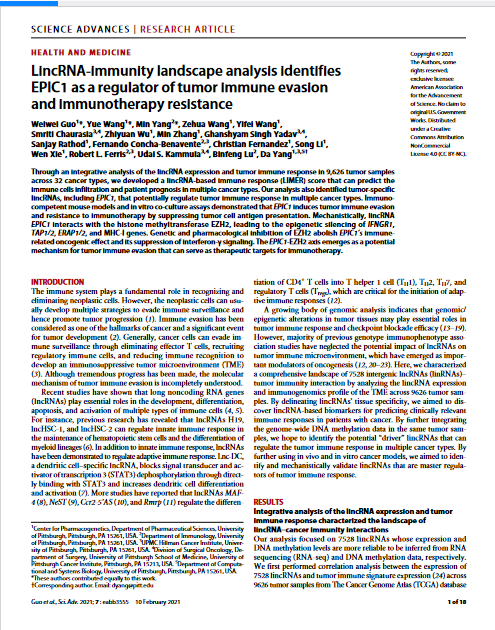30.04.2021
LincRNA-immunity landscape analysis identifies EPIC1 as a regulator of tumor immune evasion and immunotherapy resistance
Science Advances, 2021
The ability of tumor cells to evade immune detection plays a critical role in tumor development. Although mechanisms of immune evasion have been characterized, understanding of how tumor cells avoid detection by the immune system and acquire resistance to immunotherapy remains incomplete. Utilizing Bio X Cell’s anti-mouse PD-1 (clone J43) antibody, researchers discovered that expression of the intergenic long noncoding RNA (lincRNA) EPIC1 helps cancer cells escape recognition by the immune system. These findings establish lincRNAs as biomarkers for predicting clinically relevant immune responses in patients with cancer and reveal EZH2 as a possible therapeutic target in EPIC1 expressing tumors.
A team of scientists led by Dr. Da Yang at the University of Pittsburg began their work by analyzing lincRNA expression in 9,626 human tumor samples spanning 32 tumor types. They developed a scoring system called LIMER (lincRNA-based immune response) capable of estimating the extent of immune cell infiltration using RNA sequencing data. High LIMER scores were associated with better progression-free survival in several tumor types including melanoma and liver cancer. The team also found a set of lincRNAs that were exclusively expressed in tumor cells and were negatively correlated with immune response. Among these, EPIC1 was identified as the top scoring lincRNA and was selected for further study.
Further characterization of EPIC1 overexpressing tumors revealed the presence of fewer immune cells compared to control tumors. Additionally, a series of experiments in preclinical mouse models revealed that EPIC1 expression results in both suppression of antigen presentation as well as inhibition of IFN-g–JAK–STAT1 signaling. The researchers found that EPIC1 recruits EZH2, a histone methyltransferase, to chromatin resulting in epigenetic silencing of IFN-g receptor IFNGR1 and genes involved in antigen presentation.
Having established that EPIC1 is an important regulator of the immune response, the authors next sought to explore the role of EPIC1 in resistance to anti-PD-1 therapy. For this experiment, they used a mouse model and Bio X Cell’s anti-mouse PD-1 (clone J43) antibody to demonstrate that tumors expressing high levels of EPIC1 were resistant to checkpoint inhibition. They also showed that inhibiting EZH2 in EPIC1 expressing cells resulted in restored IFN-g–JAK–STAT1 signaling and MHC-I expression.
The results of this work begin to illuminate the role of lincRNAs in cancer biology as well as give clues into potential avenues for therapeutic development. Further exploration of EPIC1 expression in tumor samples could result in its development as a biomarker for resistance to immunotherapy. Additionally, EZH2 inhibitors may represent a rational therapeutic approach in patients with high EPIC1 expression.
The following Bio X Cell antibodies were featured in this publication:
- Anti-mouse PD-1 (CD279) antibody (clone J43, Bio X Cell catalog no. BXC-BP0033-2-100MG)
- Mouse IgG2b isotype control (clone MPC-11, Bio X Cell catalog no. BXC-BP0086-100MG)
>> View article


